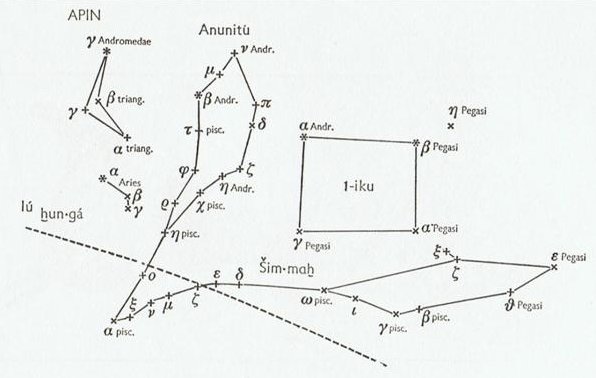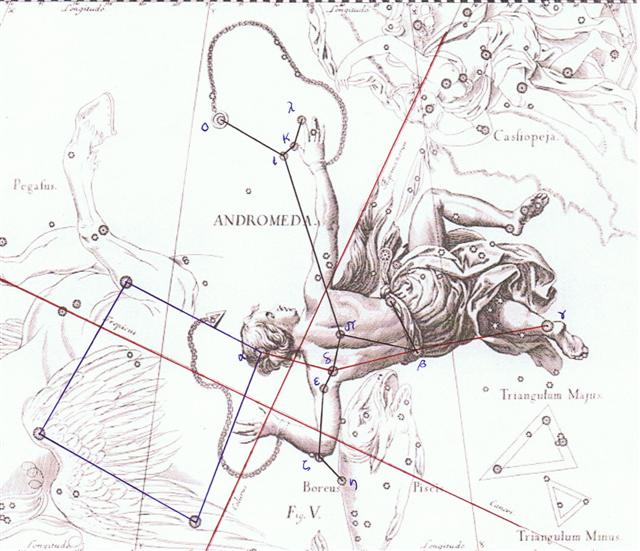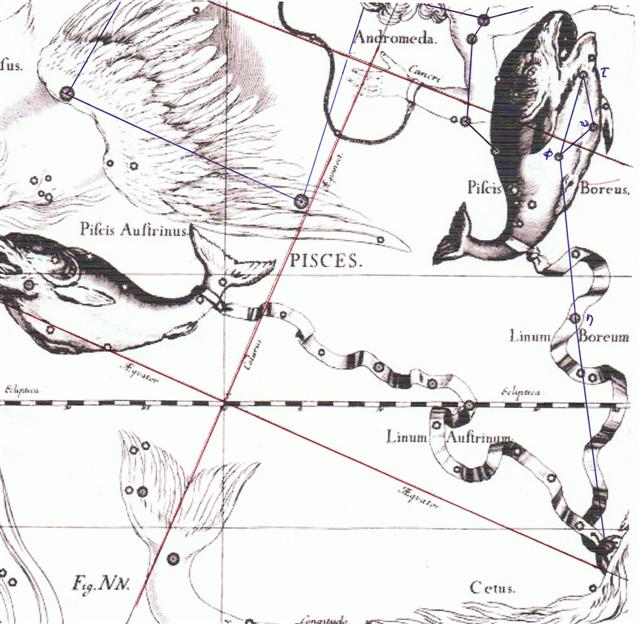4. I have added Delta (δ Andromedae) to our growing list of stars although it is not mentioned in my astronomy book. I think we should add also τ Piscium and name it Anunitum:
This star can be found if we prolong the line from β Pegasi (Scheat) to α Andromedae (Sirrah). Scheat is the 'shoulder' of the Horse it has been said (although it in the Babylonian representation corresponds to the 'elbow' of the right wing of the Swallow): ... Arabian astronomers knew it as Mankib al Faras, the Horse's Shoulder, mentioned by Ulug Beg and still occasionally seen as Menkib. Chilmead had Almenkeb. The Great Square, of which β formed one corner, constituted the double asterism, the 24th and 25th 'nakshatras', Pūrva, Former, and Uttara, Latter, Bhādra-padā, Beautiful, Auspicious, or Happy Feet, sometimes also called Proshtha-padā, 'Proshta' meaning a Carp or Ox; but Professor Whitney translated it 'Footstool Feet', and said that the authorities do not agree as to the figures by which they were represented, for by some the one, by others the other, is called a Couch or Bed, the alternate one, in either case, being pronounced a Bifaced Figure, or Twins. The Couch is a not inapt representation of the group if both asterisms are taken together, the four stars well marking the feet. Weber calls them Pratishthana, a Stand or Support, as Whitney wrote, an evident allusion to the disposition of the four bright stars which compose it, like the four feet of a stand, table, bedstead, or the like; the regents of these 'nakshatras' being Aja Ekapāt, the One-footed Goat, and Ahi Budhya, the Bottom Snake, 'two mythical figures, of obscure significance, from the Vedic Patheon'. The 24th 'manzil', formed by α and β, was Al Fargh al Mukdim, the Fore Spout, i.e. of the water-bucket, - Al Birūni's Al Fargh al Awwal, the First, or the Upper, Spout ... There are similarities between Delta (δ Andromedae) and Anunitum (τ Piscium):
Both stars are located around 30º N and rather faint. 01h 11m 39.59s for τ Piscium can be compared with 02h 02m 02.80s for Alrisha: 122m - 72m = 50m is the difference in right ascension, which translates to 50 / 4 = 12½ days. Thus I can in my table use the value 01h 59m - 50m = 01h 09m for Anunitum. Counting with a 360-day long cycle there are exactly 8 days from Delta to Anunitum. This number indicates a distance in time of ca 8 * 72 = 570 years: 8 / 365¼ * 26000 = 569 8 is a number associated with Venus, and she could be the Lady of the Heavens. ... Although Andromeda has its roots most firmly in the Greek tradition, a female figure in Andromeda's location appeared in Babylonian astronomy. The stars that make up Pisces and the middle portion of modern Andromeda formed a constellation representing a fertility goddess, sometimes named as Anunitum or the Lady of the Heavens ... The shoulder blade star of Andromeda corresponds, it seems, to τ Piscium:
Our modern view of Piscis Boreus is to have τ Piscium as the top star in a triangle (with υ and φ as the other corners). In the perspective of Hevelius τ is below the open mouth of the rising fish, the back of which is touching the left arm of Andromeda. This point of touch is just above the Tropic of Cancer (redmarked by me). Time moves from left to right and therefore τ is to the right instead of to the left as in the Babylonian view. 'Writing' from right to left is not a universal custom. Spring equinox is drawn through the midline of the tail of Cetus up through the ecliptic path of sun (horizontal band in black and white). Piscis Austrinus is drawn with the same type of tail and in the winter half of the year. Equinox is slightly later in the Pisces picture than in the Andromeda picture. The fingers of her left hand are cut through closer to their tips and her left thumb is above the Tropic of Cancer. The bottom corner of the Pegasus Square (Algenib) is closer to spring equinox. Perhaps the rising fish in Gb7-15 represents Piscis Boreus, the position of which could be determined by τ Piscium:
|
|||||||||||||||||||||||||||||||||||||||||||||||||||||||||||||||||||||||||||||||||||||||||||||||||||||||||||||||||||||||||||||||||||||||||||||||||||||||||||||||||||||||||||||||||||||||||||||||||||||||||||||||||||||||||||||







